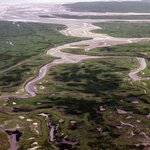Geology

Two new studies led by UC Irvine using data from NASA Gravity Recovery and Climate Experiment satellites show that civilization is rapidly draining some of its largest groundwater basins, yet there is little to no accurate data about how much water remains in them.
The result is that significant segments of Earth's population are consuming groundwater quickly without knowing when it might run out, the researchers conclude. The findings appear today in Water Resources Research.
"Available physical and chemical measurements are simply insufficient," said UCI professor and principal investigator…

Researchers have found chemical evidence for the presence of sulfur in the Earth's core. They determined the composition of the core, which is inaccessible to direct sampling, by analyzing isotopes - atoms of the same element that have different masses - of copper in various crust and mantle rocks and then comparing them with the chemical composition of meteorites, representative of the materials that formed the Earth.
Numerous seismic data have long puzzled scientists: Earth's core appears too light to be solely made up of pure iron and nickel. Various hypotheses postulate that the…

A new study shows that, from 1500 until 2000, about a third of floods in southwestern Netherlands were deliberately caused by humans during wartimes. Some of these inundations resulted in significant changes to the landscape, being as damaging as floods caused by heavy rainfall or storm surges.
During the Eighty Years' War, as the Spanish army fought to recapture territory in what is now northern Belgium and southwestern Netherlands in the late sixteenth century, the Dutch rebels led by William of Orange decided to use the low-lying, flood-prone landscape to their advantage. In an…

The central United States has undergone a dramatic increase in seismicity over the past 6 years. From 1973-2008, there was an average of 24 earthquakes of magnitude 3 and larger per year. From 2009-2014, the rate steadily increased, averaging 193 per year and peaking in 2014 with 688 earthquakes. So far in 2015, there have been 430 earthquakes of that size in the central U.S. region through the end of May.
There are many questions and misconceptions about what’s happening. How does the observed increase relate to oil and gas production activities? Does this connect to fracking—more formally…

The new disaster movie San Andreas draws on science fact - that earthquakes are a reality - and turns it into an action movie by creating a domino effect and pitting Duane "The Rock" Johnson against them.
Scientists are inclined to like that their field gets in the popular consciousness by being featured in film, unless it goes too far - rampant biological movie plots have led to the anti-vaccine and anti-GMO sect of doomsday prophecy, meaning scientists now have to spend a lot of time undoing what environmental disaster fiction has created.
Artistic license is fine, of course. For…

Salt rock behaves as a fluid and can play a pivotal role in the large-scale, long-term collapse of the world's continental margins. However, the precise way in which this occurs is laced in controversy; nowhere is this controversy more apparent than along the Brazilian continental margin, where the origin of a feature called "the Albian Gap" has generated much heated debate over several decades.
Albian Gap is a zone in the Santos Basin, offshore Brazil, up to 75 kilometers wide and within which the Albian section is missing.
In study, Christopher A-L. Jackson and colleagues enter this…

The birth of a volcanic island is a potent and beautiful reminder of our dynamic planet’s ability to make new land. Given the destruction we’ve seen following natural events like earthquakes and tsunamis in the past few years, stunning images of two islands forming in the southern Red Sea are most welcome.
Birth of an island captured by satellites. Jónsson et al., Nature Communications
The images have been published as part of a study in Nature Communications. It describes how the two new islands formed during volcanic eruptions in 2011 and 2013 respectively, are now being…

Anna Reusch, a doctoral student at ETH Zurich's Geological Institute, was making a routine research vessel run on Lake Neuchâtel when she noticed an unusual shape on the control panel screen.
At a depth of over 100 mettrs, she found something no one had ever detected before: a crater measuring 10 meters deep and 160 meters in diameter.
Reusch investigates the sediment in the lakes on the western Swiss Plateau for traces of past earthquakes, which involves taking high-resolution measurements of the floor of Lake Neuchâtel to find evidence of tectonically active zones that could trigger…

New natural gas extraction using hydraulic fracturing (fracking) has been the biggest reason American CO2 emissions have dropped but it is not without controversy. Environmentalists have taken to videos showing 'flaming tapwater' and seek to blame natural gas for it.
Thousands of years ago those same phenomena were similar religious belief - gas and oil seeps have been part of cultural practices for thousands of years. From the Oracle at Delphi to the Chimera fires, people from Indonesia and Iran to Italy and Azerbaijan have studied and been mystified by “eternal flames”.
Modern geologists…

In a new paper, researchers address the "uncomfortably close" occurrence of the Chicxulub impact in the Yucatán and the most voluminous phase of the Deccan Traps flood basalt eruptions in India. Specifically, the researchers argue that the impact likely triggered most of the immense eruptions of lava in India -- that it was not a coincidence but was a cause-and-effect relationship.
Knowledge and study of the Deccan Traps eruptions have consistently cast a shadow of doubt on the theory that the Chicxulub impact was the sole cause of the end-Cretaceous mass extinction, most infamous for…